
***This post is a part of my series where this year I will be highlighting all of the different states native frogs and toads. Check out this page to see all of the United State’s native frogs broken down by state. ***
Here are the frogs and Toads that can be found in Arizona:

The Arizona toad is typically 2-3/4″ in length and can range in color from a brown to a greenish grey with a light stripe across its head. They can typically be found in streams, reservoirs and uplands adjacent to water. In Arizona, they are found in the central portion.

The Arizona toad will lay its eggs on the bottom of shallow, slow moving streams. It is unique that the adult toads are nocturnal, however the young are active during daylight. This toad will hybridize with the Woodhouse’s toads. It’s call is a trill that will last between 8-10 seconds. Males will not typically create a chorus, but instead will be spread out singly along the stream edge.

The Arizona Treefrog is a relatively small green and coppery brown frog. It typically has a dark brown eyestripe that will extend onto the side of its body behind its legs. The throat will often be dusky green or tank color. This frog can be found in streams, wet meadows, roadside ditches and livestock tanks in forests. Within the state of Arizona, they may be found across the central portion above the Mogollon rim.

These frogs breed at the beginning of summer monsoon season with the choruses lasting only 2-3 days, however occasionally they can be heard during the summer. The call is a metallic clink repeated 1-3 times per second. I think it sounds similar to a duck quack, but listen to the call below to hear for yourself.

The Baja California treefrog can reach 2″ in length. They are typically brown or green with spots/blotches and a dark stripe across their eyes. This frog occurs along the river edges which are grown over with cattails. They are the only treefrog within their range. Within the state of Arizona, they can be found along the lower Colorado River and other scattered spots across the state as shown below.

Male Baja California treefrogs are very territorial and will engage in wresting and butting matches with other males. Breeding occurs in November through June. Their call is a distinctive “krek-ek” call which is commonly heard in Hollywood movies. Listen to it below!

The barking frog is a toad-like frog which can be olive-gray to rusty-gray coloring with irregular blotches on its back and leads. It’s toes are not webbed and they have rounded outgrowth on their feet. They are typically found in caves on rocky slopes or in woodlands between 4,200 – 6,200 ft. Within Arizona they can be found in a small portion in the Santa Rita, Patagonia, Huachuca, Pajarito and Quinlan mountains.

These frogs are very difficult to find and are located by their distinctive call which sounds like “Walk! Walk!”. They will call for 2-3 nights following the first monsoon of the season, but may be heard sporadically for the next 2-4 weeks. The female frog will stay with the eggs until they hatch and continue to provide moisture to them as needed. Unlike most frogs and toads, this species young will hatch straight from the eggs in about 20-35 days. Listen below to hear the males call.

The Canyon tree frog measures an average of 2″ in length. They only occur along the rocky stream courses within canyons. They can be seen basking on rocks or hiding in crevices. The canyon tree frog may be found across the state of Arizona except the southeastern corner.

The canyon tree frog will breed in pools alongside of the streams primarily in spring, but have been known to breed after heavy summer rains as well. This frogs call sounds like a machine gun, engine turning or a woodpecker drumming. It is a loud, nasal, rapidly stuttering ah-ah-ah. This usually lasts 1-2 seconds.

The Chiricahua leopard frog can reach 4.25″ in length. They are green or brown with numerous small dark spots. Historically the Chiricahua leopard frog could be found in the mountains and valleys along the Mogollon Rim and in SE Arizona south of the Gila River. Although it can still be found in this range, it has disappeared from 88% of its previous localities. It can be found in stock tanks and man-made waters.

They will breed April through October. The males call consists of a 1-2 second snore.

The couch’s spadefoot has a dull yellow to greenish yellow coloring with brown-black spots and can reach up to 3″ in length. They can be found in areas with prairie grassland and breed in pools and ponds filled by heavy rain. In Arizona, they can be found in a few populations within central Arizona, but mainly in the southern half of the state.

Couch’s spadefoot has a yeow croaking call.
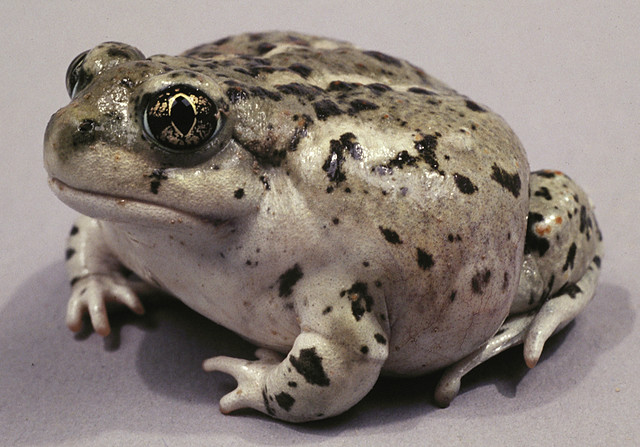
Similar to the Plains spadefoot, the Great Basin spadefoot has a vertical pupil as well. They can be greenish, gray or brown with a scattering of darker spots and blotches. Each spadefoot has a wedge shaped spade on their hind feet, hence the name. They can be found in the extreme northwestern portion of Arizona. They are locally common but seldom seen as they spend most of their life buried under the soil.

Their call is a very nasal waaaaa sound. Listen to it below:

This frog is typically 1.5″ in length, with females being slightly larger. One defining characteristic of this frog is the fold of skin on the back of the frogs head. The great plain narrow mouth toad is grey or brown in color with smooth thick skin. It can be found in grassy areas on rocky slopes and in rock filled canyons. They will hide under rocks and can sometimes be found with tarantulas. As shown in the photo below, they can be found in the extreme south portion of Arizona.

The great plains narrow mouth toad’s call is a nasal buzz lasting only 1-4 seconds. Several calling frogs together sound like bees or a bunch of toy airplanes. I was very surprised by the pitch of their call.

The great plains toad has numerous warts and prominent ridges on its head. The females will typically reach 3″ with males being less. The great plains toad can be found throughout Arizona except for the higher mountains and lowest and driest portion of the Sonoran Desert. They burrow well in loose soil and are found at night roadside or in ditches where insects are bountiful.

A female great plains toad will lay up to 20,000 eggs. The male great plains toad has a long trill call that lasts 20-50 seconds long and can vary depending on the size of the male and the temperature. Some people have compared this toad’s call to a jackhammer, but go ahead and listen to it for yourself below:
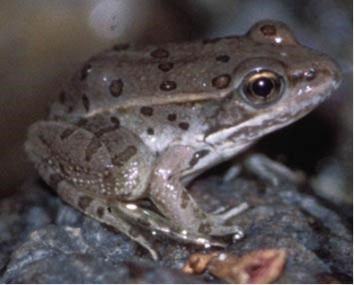
The lowland burrowing frog is typically yellow-brown with dark olive-brown splotches. It has a slight duck bill appearance due to its rounded snout. The adults can reach 2.5″ in length. They can be found in south central Arizona within valleys in the Sonoran Desert. Currently, the lowland burrowing frog is listed as a species of special concern as the tadpoles take a year or more to reach adulthood and a prolonged drought has caused pools to go dry that once held frogs.

This species spends majority of its year underground and emerges with the first substantial rain of the summer where they will breed explosively. The males call is a low pitched notes resembling a duck quack. Listen to it below.

The lowland leopard frog is similar to the other leopard frogs, but the relict leopard frog is the closest. This species is typically brown although some are green on the head. They can be found in rivers and streams. Within the state of Arizona, they can be found across the central portion.

The males will call a series of chuckles that are similar to the plains and relict leopard frog call.
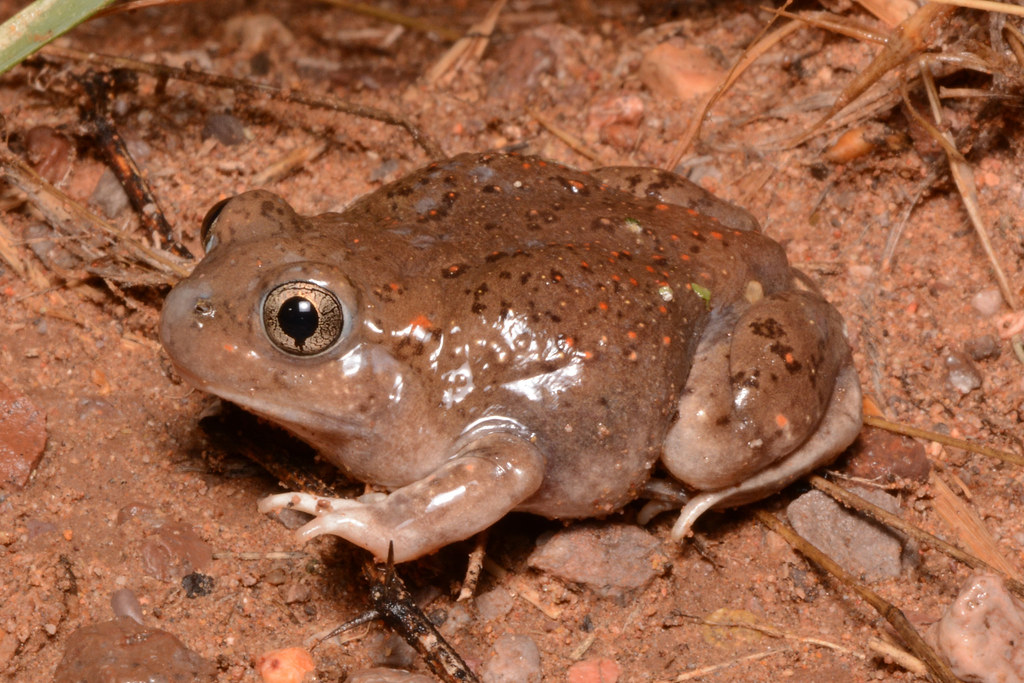
The Mexican Spadefoot are brown, grayish green or grayish brown with dark spots on its back. Red-tipped tubercles are scattered on the head and back. Like other spadefoots, the mexican spadefoot has a horny tubercle on the bottom of each hind foot which is used to dig. They can be found in grasslands and woodlands within northern and central Arizona.

The males call from the middle of the pond and it sounds like a fingernail running over the teeth of a comb. Have a listen below.
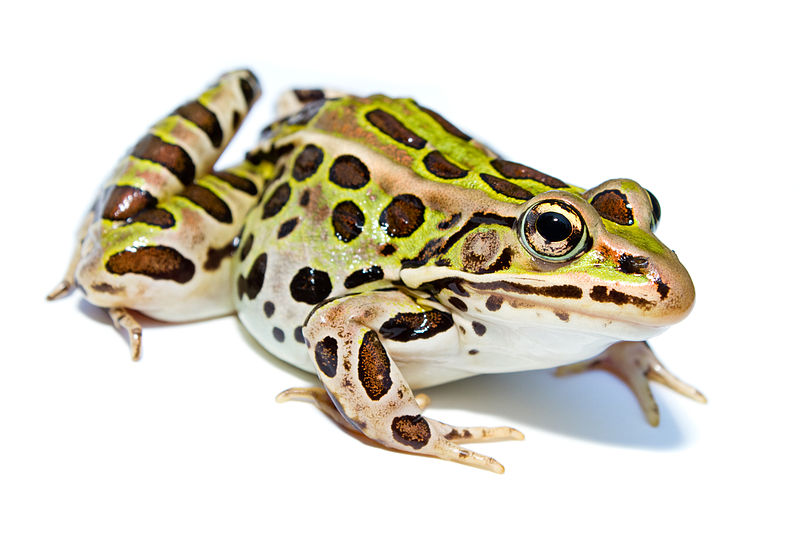
The Northern Leopard frog has 2-3 unevenly spaced rows of irregular oval shaped dots on its back. The northern leopard frog historically could be found across the northern half of Arizona. However the numbers appear to be declining and it is now limited to a couple small areas within the state of Arizona. It needs 3 different habitats to match its lifestyle – permanent water for overwintering, floodplains & marshes for breeding & meadows and fields for foraging.

These frogs are opportunistic feeders, meaning that they will eat anything that fits in their mouth including beetles, ants, smaller frogs – including their own species, birds and even garter snakes. It’s call is like a low and rumbling snore and grunt sound. It has also been known to scream loudly when grasped or frightened by a predator. Listen below to their call.

This frog is brown with large rounded dark spots with light borders. As you can see from the photo above, the ear drum is very distinct. The Plains leopard frog is known for its distinctively broken and displaced skin ridges along the back and can reach 3-3/4″. They can be found near streams, ponds, creeks and ditches. In wet, mild weather, they may be found far away from water. The range of the Plain’s leopard frog is limited to the western portion of the valley.

Female plains leopard frogs will lay a mass of eggs which can hold up to 6,500 eggs. Tadpoles will become frogs in midsummer or may even transform the following spring. The plains leopard frog’s call includes a few low grunting sounds along with a series of short clucks. Listen to their call below:

The Plains spadefoot is known for its vertically elongated pupil and markings similar to a hourglass on its upper sides. The plains spadefoot spends most of its life buried in the soil, but will emerge to breed after heavy rains in spring or summer. They can be found in sandhills, grassland and the plains of the northeastern and southeastern corners of Arizona.

The call of the plains spadefoot is a brief snoring sound. Take a listen below.
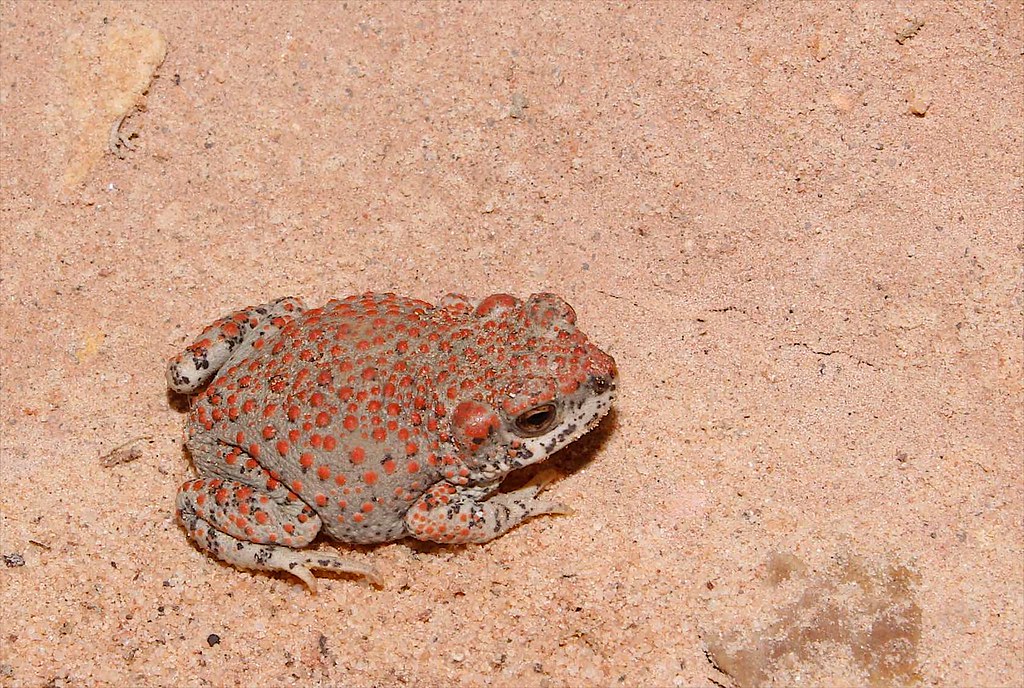
The red-spotted toad is unique due to its gray or brown coloring and red/orange warts. They can reach 3″ in length and can be found in rocky canyons and streams or burrowing under rocks. Typically found in across Arizona except for the highest areas and the Yuma Desert areas as shown below.

The red-spotted toad has an unusually high pitched trill which can last 3-12 seconds. During the breeding season, the males throat color may darken.

The Relict Leopard frog has been found around Lake Mead within Arizona. Drought followed by heavy flooding in 2006 may have eliminated more populations.


The Sonoran Desert toad can grow up to 7.5″ in length and typically have smooth olive-green/brown skin. This toad prefers semi-desert grasslands and woodlands up to 5,800 feet. Within Arizona, it can be found across the southern portion of the state, except for the higher mountains and the arid western desert valleys.

Breeding will take place on 1 night within 2-3 days of a 1″ rainfall event. They will use ponds, cattle tanks or backwaters to breed within. The males call is similar to a short ferry boat whistle. Listen to it below!

The Sonoran green toad can reach 2″ in length. The coloring of the Sonoran green toad is quite amazing with oval or circular patches of green, greenish-yellow or yellow. Males will have a dark throat and the females will have a cream or white throat. This species prefers semi-desert grasslands which have areas of water such as roadside ditches or cattle tanks. Within Arizona, they can be found in the southeastern valleys.

The male’s call is an insect like buzz lasting 2-4 seconds. Listen to it below.

The Tarahumara frog is a brown frog that may have an olive green wash or tinges of yellow-orange. The legs have dark bandings where the back has dark spots. This frog is typically confused with the bullfrog which can grow much larger than the 4.5″ Tarahumara frog. This species may be found in rugged canyons with deep pools. In Arizona, they had disappeared from all of its area by 1983, however they have been reintroduced into the Santa Rita Mountains.

The males have many different calls including a gentle snore, a whine, a short squawk or a distress call.

The western chorus frog is known for its dark stripe on the side of the body which extends from snout to groin. The sides of its body can range between green – brown – reddish. These frogs can be found throughout central Arizona as shown below.

The western chorus frog makes a preeeeep sound that will ascend in pitch. Listen to the call below!

The Western green toad is a small toad that is green with yellow-green and black spots. They can reach up to 2″ in length. This toad is primarily nocturnal and lives in rodent burrows. Within Arizona, it can be found in the southeastern corner of the state.

Males may be heard calling during the day at peak summer breeding season. Listen to their call below.

Woodhouse’s toad can vary in color from yellowish brown to greenish grey with a light stripe down the middle of its back and can reach up to 5″ in length with the males being smaller than females. These toads can be found primarily in deep soils in river valleys and flood plains. They burrow into soil to escape drought and cold. Woodhouse’s toad is common and can be found almost statewide except for the arid western deserts and the highest montane areas.

These toads breed from April to June in marshes, rain pools and other areas lacking strong current. This toad’s call is a loud wahhhhhh lasting between 1-4 seconds and emitted several times a minute.

Cover photo used by the creative commons license. Text was added. See Original photo by Bernard Gagnon here.
For more information:
Like “The Frog Lady” on facebook or follow aapanaro on instagram to get some sneak peeks into the frog lady’s frog room!